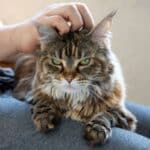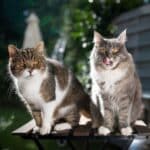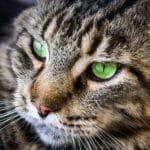We know and love the Maine Coon but where did the Maine Coon Tabby Mix originate? What are the main characteristics? You can find out more about the breed below!
Jump to:
Purebred or Tabby Mix?
The breeding of the same species often over many generations is known as "purebred." Purebreds have a general set of standard features, including color, size, and temperament. Occasionally, two different breeds will mate and produce a "mixed breed." A mixed-breed cat is the offspring of one or more different breeds, often purebred and domestic.
History of the Maine Coon Tabby Mix
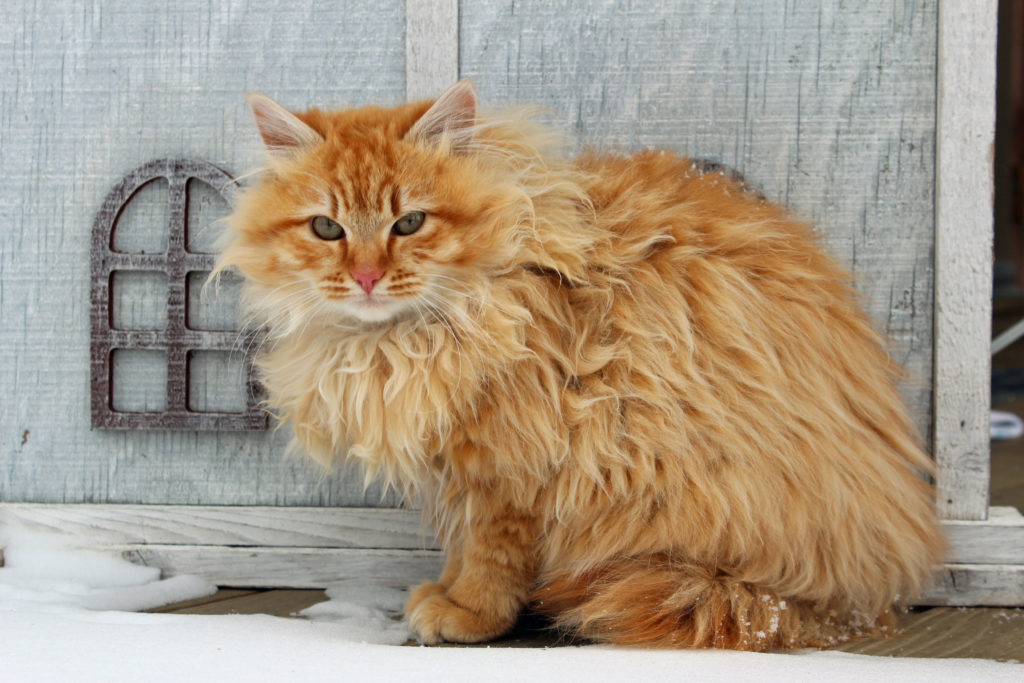
The Maine Coon Tabby Mix is a relatively new breed that has emerged in recent years. While not yet accepted for show, they have been recognized by international Maine coon clubs as an admired genetic variant and are now being bred to keep Maine coons beautiful without losing the Maine coon's main features.
We know from the history of the Maine coon that this cat has traveled across many different countries. From Maine (of course!), it spread through Europe and Canada where it became extremely popular among Canadians.
Many believe a mix between a raccoon and wild/domestic cats produced the Maine Coon, but this has been proven to be biologically impossible. It’s rumored that they were bred from Marie Antoinette’s cats that she sent over to Maine on a ship.
Once in the US, they were crossbred withestablished breeds like British Shorthair and American shorthairs. Whether or not some of these rumors are true, we may never know. Whether Maine Coons descended from a long-haired overseas cat that mated with a short-haired domestic is still unknown.
Appearance
The Maine Coon and the Maine Coon Tabby Mix have the same number of genes for their Maine Coon characteristics but the Maine Coon Tabby Mix inherits a gene called "chondrodysplasia" which makes it smaller than the original Maine Coons.
Males tend to grow to 10 – 16 inches tall whilst females are slightly shorter at 8 - 14 inches. They both tend to be around 40 inches in length. Weight is up to 25lbs for males and 15lbs for females. Reaching this full size can take anywhere up to 5 years.
The Maine Coon Tabby Mix has distinctive eyes with a mixture of round and slanted features. Maine Coon Tabby Mixes have markings from the eyes to the ears, known as mascara markings due to their look.
Most all Tabby Cats have a distinctive M marking on their forehead and this can still be seen in the Maine Coon Tabby Mix.
According to Christian folklore, a legend tabby cat showed up to comfort baby Jesus. In gratitude, Mary stroked the cat's head and left an 'M' mark on its forehead. To reward cats for their loyalty, all tabby cats from then on were marked with an 'M'.
They perhaps weren't as lucky when it comes to ear tufts as not all Maine Coon Tabbys will have, though almost all will have lynx-like ears. All Maine Coon Tabby Mix have stripes of darker fur on their legs, patches of darker colors on their bellies, a darker stripe of fur along their spines, and rings around their tails. The rings around the tail remind people of raccoons hence the stories told.
The Maine Coon Tabby Mix coat typically includes patterns such as Mackerel, Spotted, Classic or Blotched, and Marble.
Mackerel
The stripy tabby pattern is similar to a mackerel, hence its name. A series of thin horizontal stripes running down the cat's sides.
Spotted
The spotted pattern can be found as a broken mackerel or classic pattern, often with a few lines ranging from elongated to rounder spots.
Marble
A ticked base coat with overlaying stripes/swirls on legs, neck, chest, and face.
Classic
The classic is also known as the blotched pattern because of pronounced blotches on the flanks. Butterfly-shaped motifs across the shoulders and pronounced blotches on the flanks.
As Maine Coons have at least 80+ colors and patterns there is an abundance of Maine Coon Tabby Mix colors out there. The difficulty comes in choosing one!
Coat, Grooming, and Shedding
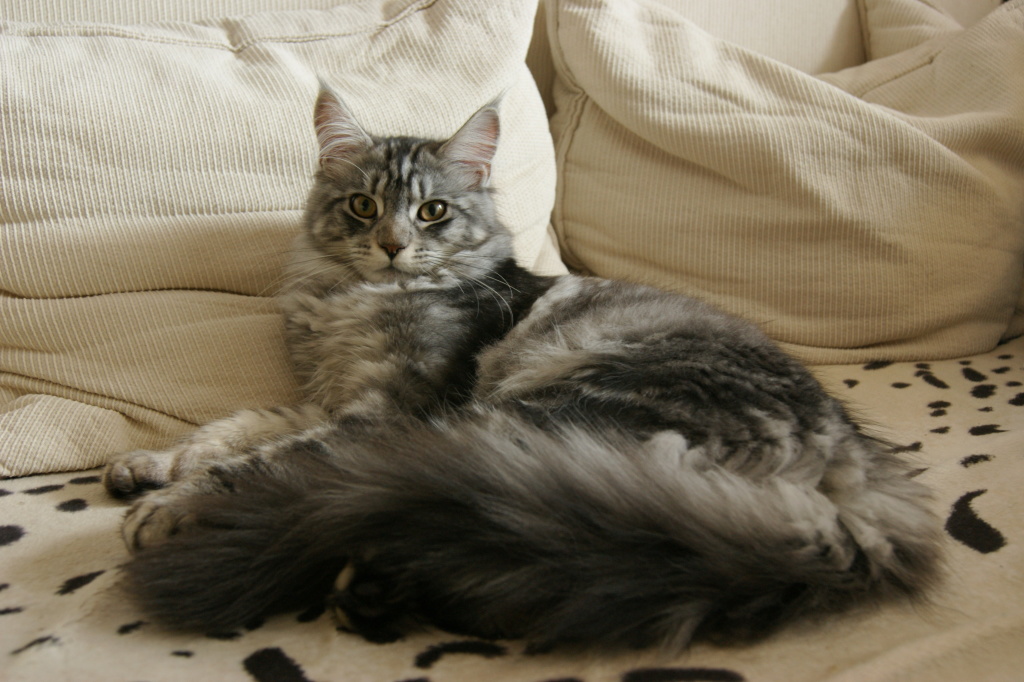
Purebred Maine coons have distinctive ruffs of hair around their neck and are built with a coat that handles the harsh winters. They have thick undercoats and light fluffy coats that are usually medium to long-haired.
Maine Coon Tabby Mix coats are just as unique. Being a mixed breed they can lose some of their fluff and some of the tell-tale unique qualities like the neck ruff of the fur of the purebred Maine Coon. Some Maine Coon Tabby Mix cats will have a main coat of fur while others may have the main coat with shorter, thicker undercoats that feel very soft and fuzzy. Their tails are always very fluffy and full.
Maine Coon Tabby Mixes who have the long main coats will need a bit of extra care and attention when grooming. It doesn't mean the short main coats miss out, brushing regularly will help to keep the main coat clean and tatt-free on all coat lengths. Removing dead hair can prevent many trips to the vet with a miserable pet as all types of Maine Coons are prone to hairballs.
Shedding happens seasonally in Spring and Autumn. Just like us when we change our heavy winter coats for a lighter version in spring your pet does the same. All versions of your cat's coat will be fluffy all year round.
Maine Coon Tabby Mix Breed Characteristics
The Maine Coon Tabby Mix is very much like its parent breeds - intelligent and affectionate! Outgoing, friendly, and confident they make great pets as they enjoy human contact and playfulness.
The Maine Coon Tabby Mix is very adaptable and tends to get on well with all the family, including other animals. Care should always be taken when introducing any pet to a new environment or living thing. Their dog-like traits earn the Maine Coon Tabby Mix the 'dog of the cat world' title.
Owners say training this cat is much like training a dog and in true dog fashion, your Maine Coon Tabby Mix may also be trained to walk on a leash!
The Maine Coon Tabby Mix is super friendly and longs for company. They will love to be around you so don't be surprised if they end up following you everywhere. Curiosity is a trait and you'll be sure they want to be involved in whatever is going on. Smart with good problem-solving skills, this cat will find its way in achieving what it wants.
Indoor or outdoor
All Maine Coons are an interesting mix of personalities, they can be kept as indoor or outdoor cats.
With any house cat, it's important to make sure they get enough exercise and mental stimulation. It's also important to make sure they are safe in their environment.
The main issue with outdoor cats is companionship and safety. Maine Coon Tabby Mixes will be equally happy being an indoor or outdoor cat but do get over-excited when near windows or doors as they love to look out of them!
Aside from the usual access to fresh food and water at all times. A shelter (the screened-in porch is ideal) away from main traffic areas is recommended, as well as a litter box. Cat trees, scratching posts, and toys
are a must!
Maine Coon Tabby Mix Health
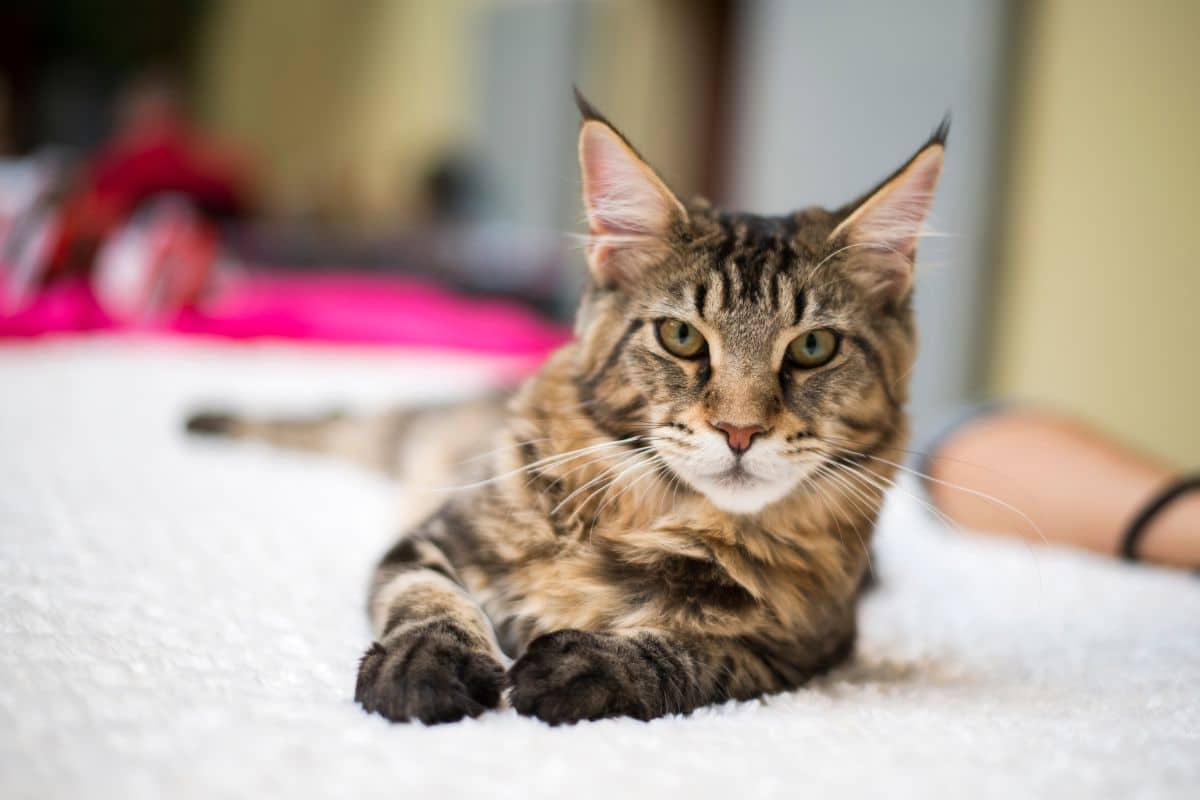
Some health concerns of the Maine Coon Tabby Mix are:
Hypertrophic cardiomyopathy
Hypertrophic cardiomyopathy is the thickening of the main muscle of the heart (left ventricle) and can lead to other problems with the structure of the heart.
Hypertrophic means enlarged as in muscular, going against its normal shape or thinning. Cardiomyopathy means disease of the myocardium; contraction that is directly connected to the main muscle of the heart. This main muscle is what works together with your cat's blood vessels to pump blood around their body, from their main organ (the heart) through all of their blood vessels.
Hypertrophic cardiomyopathy is a condition that affects Maine Coon cats and others very slightly too. Only three main breeds are affected, those being the Maine Coon, Norwegian forest cats, and Scottish folds.
In Maine Coon cats it affects very few of them. There is an estimated one Maine Coon for every 10 who have hypertrophic cardiomyopathy. The disease is hereditary and researchers have identified the genetic mutation that causes the development of HCM in the Maine Coon. A genetic test that allows breeders to screen cats before breeding them is available. Any cats identified with HCM should be removed from breeding lines.
Hip dysplasia
Hip dysplasia is a hereditary defect in the hip joint and is one of the most common pet health problems affecting most larger breeds of cats and dogs. Affected animals will typically have a painful limp when they walk due to progressive degeneration of the hip joint. If left untreated this can cause stiffness in the joint and a significant drop in mobility.
Maine Coons who will be bred should have their hip x-rays taken by a specialist vet when they are 2-years old. They will be rated or scored. Don't be afraid to ask your breeder for the parent's hip score ensuring you give your Maine Coon Tabby the best possible start.
Spinal muscular atrophy
Spinal muscular atrophy is a form of motor neurone disease (MND). The main symptoms are progressive muscle weakness, wasting, and paralysis. Spinal muscular atrophy is a genetic disorder that causes the nerves in the spinal cord to waste away.
When this occurs, it leads to loss of movement and function of the skeletal muscles. Kittens with SMA will walk with a swaying rear end and have difficulty jumping. They can also live an otherwise normal life. A DNA test to identify carriers or to diagnose possibly affected kittens is available.
Polycystic kidney disease

Polycystic kidney disease is a congenital (present at birth) disease of the main organs. In this case, it's in the kidneys, but it can also be in a main organ's muscles or nervous system. The main cysts are abnormal pockets of fluid that form inside the kidneys. When they do, they may grow larger and divide into smaller cysts, or smaller cysts can merge to become larger ones.
The main causes of this disease are unknown, though it does tend to cluster in Maine coon families and breeds with similar inherited diseases. It is thought to be a genetic disease that requires careful breeding programs and screening for any genetic mutations.
A Polydactyl Maine Coon
A polydactyl Maine coon is a cat that is born with extra toes. It's a trait, carried on the X chromosome, and it can be present in either sex. In males, it is often hidden by other physical traits, but you will often see
females in cat shows with an extra toe or two!
Polydactyl Maine Coons are slightly more prevalent in feral populations than domestic cats. This is thought to be because they catch prey with their paws more often than domestic cats do.
The main health concern for a polydactyl Maine coon cat is that they could potentially have extra toes on their rear feet, which can get in the way and become caught up during grooming or playing. There are no major health concerns with having extra toes, but there is a higher chance of them being injured.
Stomatitis
Stomatitis is an inflammation of the mouth that is most commonly caused by the feline herpes virus, though it can be other viruses or bacteria. The main symptom of this condition is ulcers on the surface of the lips or mouth.
Periodontal disease
Periodontal disease is one of the main diseases that affect Maine Coon cats. It is considered a disease of civilization, as it doesn't really occur in the wild. It is the progressive destruction of the gum tissue around your cat's teeth. The main inflammatory cause of the periodontal disease is bacteria entering between the teeth and gums, which then begins to destroy the gum tissue and bone.
Obesity
The main health concern for any Maine Coon cat breed is that they are prone to becoming overweight. You must try your best to keep their weight under control. Obesity is an even bigger problem in Tabby cats than the Maine Coons, so you really need to keep an eye on your Maine Coon Tabby Mix's weight.
Lifespan
When adopting a pet, one of the many things to consider is how long they may live. A Maine Coon Tabby Mix generally lives between 11 and 15 years old. They are slightly shorter in lifespan than Maine Coons. You can find maine coon kittens for sale on many websites online.
Like with all long-living pets added health problems are going to arise with time but this shouldn't put you off owning one. Some things we can control like selecting good breeding from the start, attending veterinary appointments, and overall looking after the health of our pets.
Remember these beautiful cats take nearly 3-5 years to develop so watching them grow into adults is a very enjoyable experience. A Maine Coon Tabby Mix can live a long life and become a very important member of your family. And because of their affectionate nature that's a lot of love.

